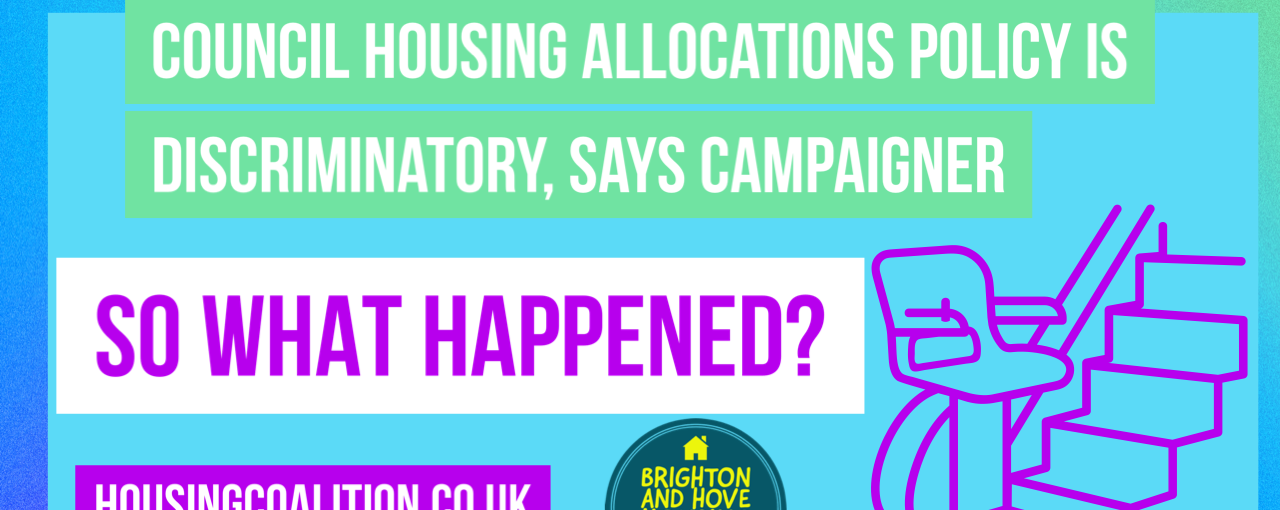Housing allocations plan is discriminatory says Campaigner
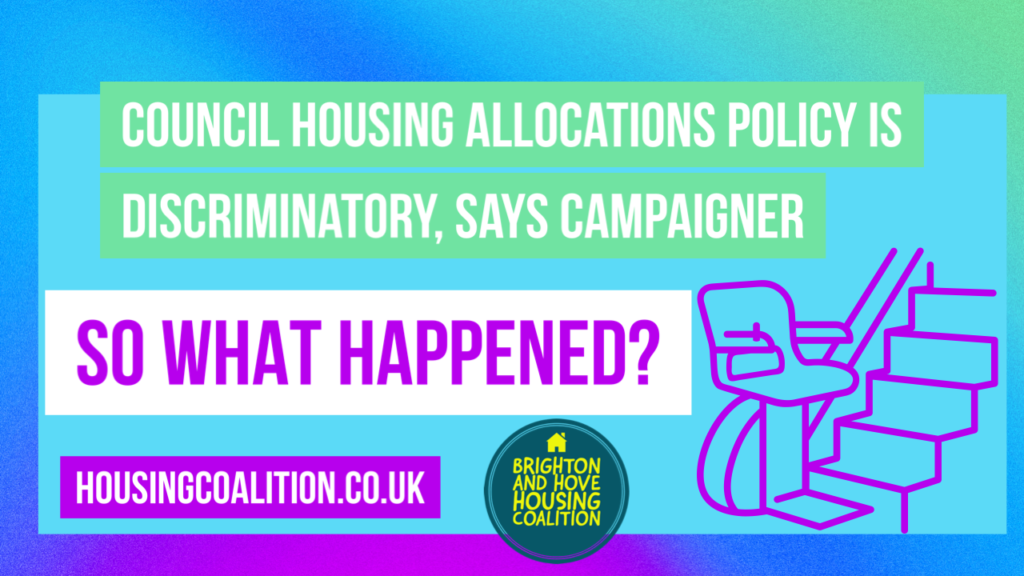
Housing Allocations Plan is Discriminatory, Says Campaigner
Introduction
Firstly, the council’s current policy of allocating only 5% of advertised properties to those in the transfer queue may be in violation of the Equality Act 2010. This act prohibits discrimination on the grounds of disability, and with 62.1% of people in the transfer queue being disabled, it is clear that this group is disproportionately affected by the council’s policy.
Additionally, the council’s failure to conduct an Equality Impact Assessment before making changes to their allocations policy may also be a violation of the Equality Act. This assessment is required to ensure that any policy changes do not have a negative impact on protected groups, such as those with disabilities.
The council’s policy may also be in violation of the Human Rights Act 1998. Article 8 of the act guarantees the right to respect for private and family life, and the council’s policy may be infringing on this right for those in the transfer queue who are in need of adapted housing.
Furthermore, the council’s policy may also be in violation of the Localism Act 2011. This act gives local communities more power in decision-making, and the council’s failure to consult with the community before making changes to their allocations policy may be in violation of this act.
Finally, the council’s policy may also be in violation of the Housing Act 1996. This act requires local authorities to secure a sufficient supply of housing, and the council’s policy of allocating only 5% of properties to those in the transfer queue may not be meeting this requirement Which has now been increased to 30% but where will the adapted properties come from and will this 62% affected increase as a result?
In light of these potential violations, I recommend that the council revises their allocations policy to ensure compliance with these laws and regulations. This may include allocating a higher proportion of properties to the transfer queue, conducting an Equality Impact Assessment before making policy changes, and consulting with the community before making any changes. This will help to ensure that all residents in Brighton and Hove, including those with disabilities and those in need of adapted housing, have equal access to safe and suitable housing.
Last Week I (Daniel Harris) attended and asked a question at the Housing committee. I asked the chair David Gibson:
“Having reviewed the allocations stats provided, I and a lot of current service users have issues with the former allocations review, how that was conducted and how this seems to have impacted persons with disabilities. None of the temporary options presented are useful, We would present an alternative plan for the 6 months to the following:
Homeless – 35% Transfers – 25% Homeseekers – 25% CIQ – 15%
Can you please consider this and reject the officer recommendations?“
I then went on to ask the following Supplementary Question:
“The data is all over the place, you read housing work plans and they state one figure 7500 homemove households, this report states 4k, the FOI is also different from the report, how are we to believe anything this council puts out in terms of data.
Can you assure us that the recommendations will meet the 30% minimum Transfer Target for transfer priority acknowledging the large number with disabilites? Will you acknowledge the need for a housing plan for the specific adapted/ suitable homes which need to come forward on Homemove, this will need a broader number of adapted homes either being built asap or brought?”
General Feelings About Sussex Homemove
When I think about Sussex Homemove I do get frustrated, I have been speaking out about this service for years, I was at the allocations review when I went to housing committee the last time and warned on elements which were seriously complicate from the consultation claims to added areas, giving the council he power to kick your off the list for rejecting one property, was even supported by a tory amendment by Cllr Mears which amended to two rejections, leaving some choice in the choice based lettings scheme.
So it is no surprise to see proposals being rushed though without the due diligence and relevant facts to enable some of the officer recommendations which will do little to help those with disabilities stuck on the transfer priority queue, actually being put at a disadvantage due to the fact they have declared a disability and are in need of adapted stock which is simply not coming forward, blocking up the system and causing years of misery to groups whom have rights and protected characteristics.
“Something is going wrong, we have got to look at this out of the box, you have got to apply on it because it is the most important in the world is to have a home”
Cllr Grimshaw Tweet
Something is going wrong, we have got to look at this out of the box says Cllr Grimshaw on Homemove
In the debate meeting above from the Housing Committee on the Allocations Operational Review of the plan and policy last week. You see some passionate debate around the policy and plan, and in particular Cllr Grimshaw, who herself was an applicant on Sussex Homemove, said “
“What I found out was is that say for example you have twenty properties there and only maybe one property was available for a disabled registered person to bid on and what I don’t think people realise that when were saying that this disproportionate affect on disabled people is mitigated by the fact that you bid on properties which are already adapted are sort of separate from the main list, is that by actually declaring your disability and having that noted on your home move application you are actually limiting your chance of which housing stock you can actually bid on”
Cllr Grimshaw went on to say;
“if you ever go on the Facebook homemove support page which I am on on, I didn’t comment very much because obviously I am a councillor, I didn’t comment at all really I just used to watch and was interested what people said. You would frequently saying well I am disabled I have got a disabled thing on my file, I am classed as disabled but I’ve actually been stuck for ten years and I can’t get a property, and then they will go, well actually I am in a two bed flat and I only need a one bedroom, and then some young mother with two children stuck in a one bed says “but I am stuck in a one bed and I desperately want a two bedroom”
What Happened after the last Housing Allocations Policy Review.
There were at some stage uptown 24,000 households on the council housing waiting list, a few changes came into play;
They removed Band D
The Introduced a 5 year local connection rule, and excluded thousands of households.
Introduced Bidding Rules which meant those not bidding regularly were ever excluded or forced to take properties.
Increased the lettings priority for homeless priority households to 40% of all allocated properties going to a homeless priority applicant.
Controversial Consultation and lack of service user participation.
What are the proposed changes to the housing allocations plan and policy?
To amend the allocations plan from the following:
Group/Queue and Proportion of properties advertised
Homeless 80%
Transfers 5%
Homeseekers 5%
CIQ 10%
To:
Group/Queue and Proportion of properties advertised
Homeless 50%
Transfers 30%
Homeseekers 10%
CIQ 10%
The proportion of lets to each group since the Allocations Policy was approved
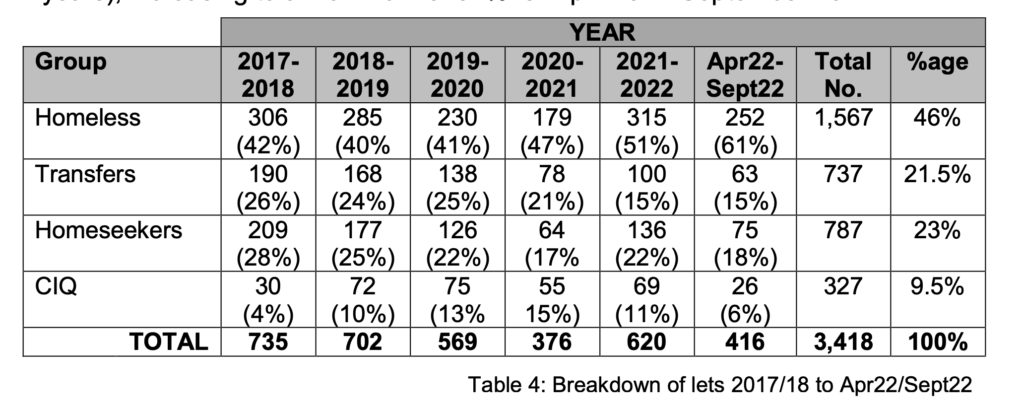
So basically since 2019 – to date sept 2022 only 379 transfers. compared to 358 transfers from 2017/2018 – 2018/2019. Due to a general decline in the number of placements over the last few years, transfers went down to as low as 15% for two consecutive years in 2021/2021 – April 2022/sept 2022.
Those in the Homeless Priority Group faired much better, Gaining a total od 1,567 placements or 46% out of the total 3,418 placements which have meant applicants have moved home.

The increase in allocations has meant the numbers of people placed in emergency accommodation have now reduced to lower than pre- pandemic levels at 524 households. It is worth noting the number of people placed in supported accommodation has sky rocketed to over 700 households. Many of whom are likely not even on the council housing waiting list due to the way the council homeless prevention is done via third party organisations and therefore people are often not on the correct statutory housing duty. I wrote about the benefits in in-house local authority owned supported accommodation recently, and how we can benefit from reforming the service.
So what are the Allegations of Discrimination
Are you struggling to find a room in Brighton and Hove?
Bearing in mind the fact that and its quoted in the report
3.12 General Principles: Transfers create new lets
“If a property is let to a household from the Homeless, Homeseeker or CIQ group, then this is a single ‘transaction’. In other words, there is one household moving into one property. However, households moving from the Transfer group will create a subsequent void in the property they move from. Therefore, this involves multiple transactions. Furthermore, households from the Transfer group may well be looking to move to a smaller property, which in turn creates a void in a larger home, which will tend to be much rarer within our housing stock. Therefore, it may not be advantageous to significantly reduce the number of lets being advertised to this group.”
And this under:
3.13 General Principles: Equalities Impacts
“However, some differences are far larger. There is a higher proportion of households with a disability in the Transfer group (62.1%) compared with those from the Homeless group (12.9%). There is also a higher proportion of disabled households in the Homeseeker group (21.3%) than the Homeless group (12.9%). Therefore, increasing the proportion of lets to the Homeless group will disproportionately affect disabled households. However, this is mitigated by the fact that properties which are already adapted will only be offered to disabled households, irrespective of their Register category. Please note a more detailed Equality Impact Assessment is provided in Appendix 3
You can clearly see “something has clearly gone very wrong” as quoted by Cllr Grimshaw, How is it so many from a particular group, already given littler to no priority under the allocations are put at a disadvantage to other lets simply for delaying a mobility or disability need? the report clearly highlights discrimination, and this should be challenged at the high court.
Why?
Lets take this applicant called Lauren who wrote into the committee but was not allowed to participate even though Lauren nominated Myself to ask a question on her behalf due to needing to care for her son: “
Lauren
I write to you today to ask that you reconsider the percentages of properties and banding that is released. Like myself their are many people in impossible living circumstances with disabilities unable to live a normal/happy life.
Over the last 5 months I have been in contact with Rachel Finchie regarding my own housing needs and outlined how I believe the housing banding is wrong. There are people with disabilities stuck in housing they cannot live in due to a lack of properties being put available to them.
This is causing a massive effect on people’s mental health as-well as physical, I believe something should be done. I recommend the administration to provide percentages provided by Daniel Harris or I will be seek- ing legal action.
Supplementary
The Allocations Policy in Brighton and Hove, as well as the Localism Act and other laws, require that local authorities take into account the needs of disabled households when allocating social housing.
I appreciate the numbers will go up. I urge the next administration to build more homes which are adaptable & suitable for those with disabilities. The policy should not discriminate against disabled people, and should make reasonable adjustments to ensure that we are not put at a disadvantage.
Why did the council put 62.1% disabled Transfer Priority Applicants, or 699 households at a significant disadvantage compared to non disabled households?”
From the Recommendations:
In the pros and cons there is a mention of “Maintains a good proportion of lets to Transfers” but nothing on the 62% or 600 disabled or mobility impaired households and how the change will affect them. Without the adapted homes coming forward, what hope to you have. There is a serious need for change and a legal challenge from households affected could be an important route to sorting this injustice,.
When The Council Ask you to refer to the equality impact assessment in Appendix 3 under disability its simply left blank.
This was approved by the Brighton and Hove Clinical Commissioning Group but not signed off shows gross negligence and reason to believe breaches in the law, particularly relating to the localism act 2011 equality act 1997 and other areas.

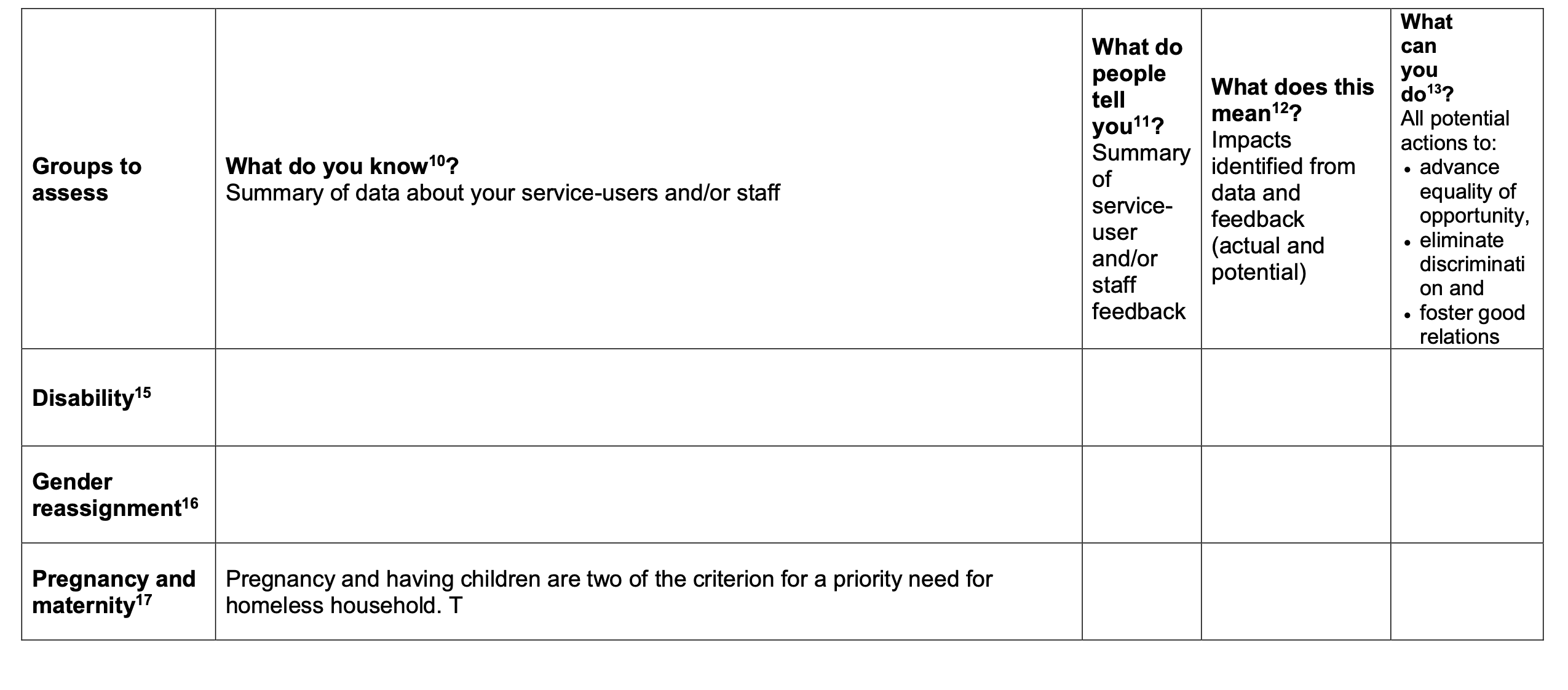
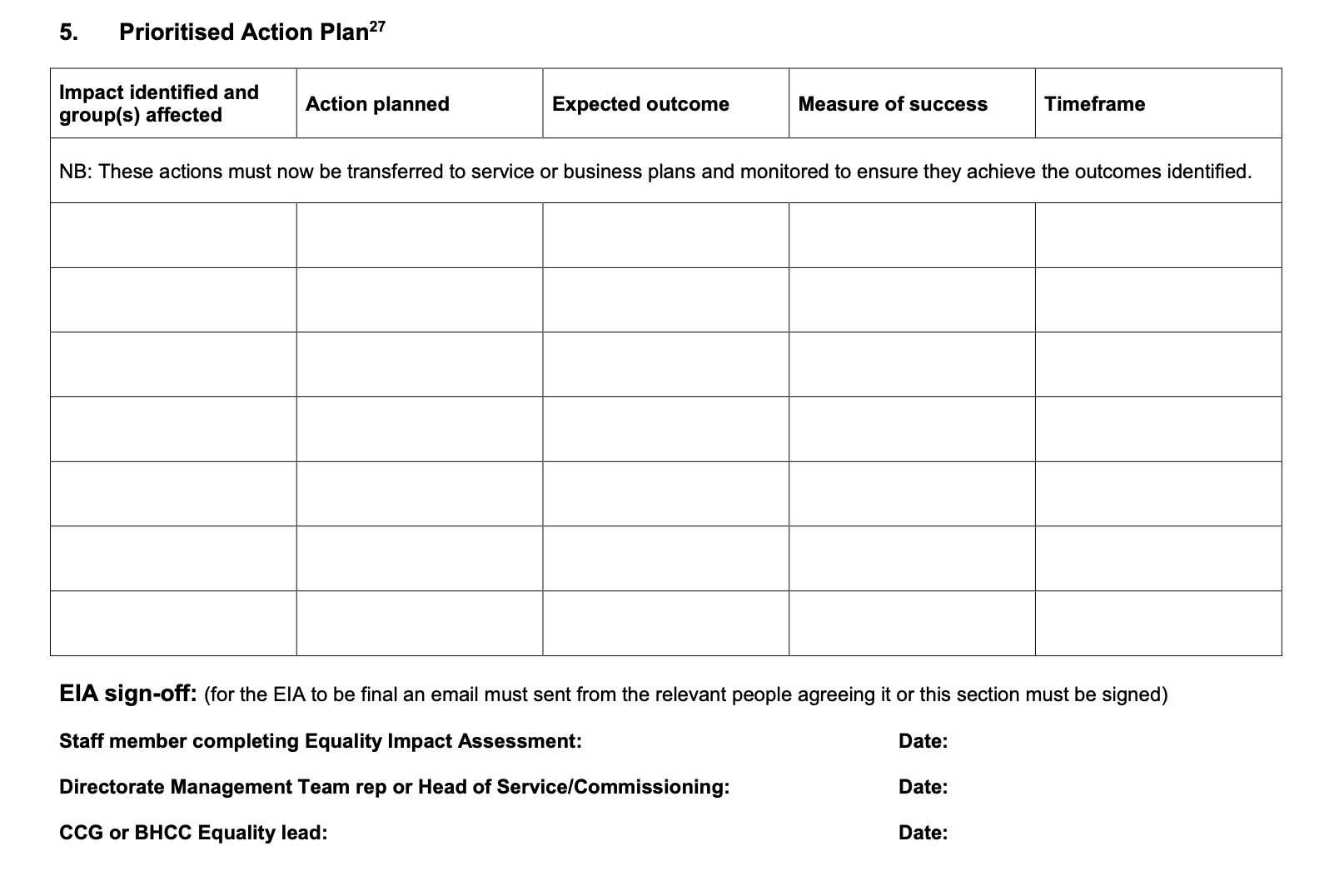
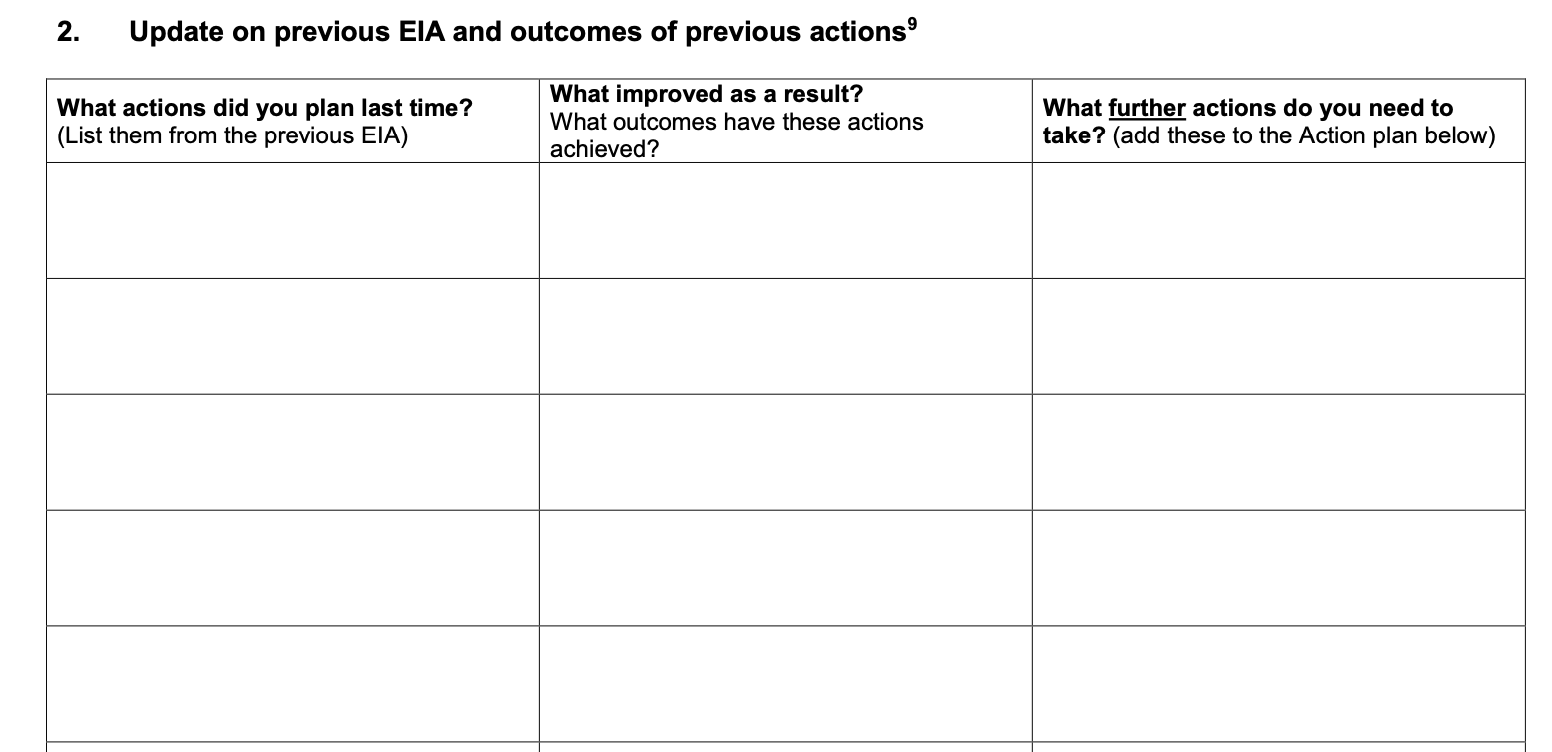
Conclusion
The laws that I have quoted in my article that have likely been broken are the Equality Act 2010, the Human Rights Act 1998, and the Localism Act 2011. These laws all provide protection for individuals with disabilities, including the right to not be discriminated against in housing.
The Equality Act 2010 prohibits discrimination on the grounds of disability, including in housing. This means that individuals with disabilities should not be treated less favorably than others when it comes to housing. Additionally, the Act requires public bodies, such as local councils, to take positive steps to ensure that individuals with disabilities are not at a substantial disadvantage compared to others.
The Human Rights Act 1998 incorporates the European Convention on Human Rights into UK law, which includes the right to respect for private and family life (Article 8) and the prohibition of discrimination (Article 14). This means that individuals have the right to respect for their private and family life, including the right to a home, and should not be discriminated against.
The Localism Act 2011 gives local authorities the power to determine their own housing allocations policies, but also requires them to have regard to the needs of vulnerable groups, including individuals with disabilities. This means that local authorities must take into account the needs of individuals with disabilities when determining their housing allocations policies.
In my article, I have highlighted concerns about the housing allocations plan in Brighton and Hove, which I believe is discriminatory towards individuals with disabilities. I have provided evidence that the majority of people in the transfer priority queue are disabled, yet the council has reduced the proportion of properties advertised for this group to just 5%. This is a violation of the Equality Act 2010, as it means that individuals with disabilities are being treated less favorably than others when it comes to housing.
To remedy this, I have proposed an alternative plan for the 6 months, which includes 35% of properties for homeless, 25% for transfers, 25% for homeseekers and 15% for council interest queue. This plan is aimed at addressing the needs of vulnerable groups, including individuals with disabilities, and is in compliance with the Localism Act 2011.
To conclude, the housing allocations plan in Brighton and Hove is discriminatory towards individuals with disabilities and is in violation of the Equality Act 2010, Human Rights Act 1998, and Localism Act 2011. It is important that the council reconsiders its policy and takes steps to ensure that individuals with disabilities are not at a disadvantage when it comes to housing. Additionally, it is important for the council to ensure that children are provided with the right to respect for their private and family life, including the right to a home, and to take steps to address the poor housing conditions that are contributing to child deaths in temporary accommodation and extremely long waits for disabled people in the Transfer Priority Queue adversely affected by the above.
Tired of the wait? Get in touch with Brighton and Hove Housing Coalition and Share Your Experiences with Sussex Homemove
if so we want to hear from you. or leave a comment.

